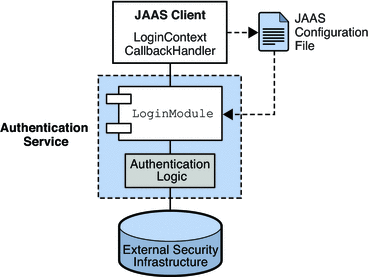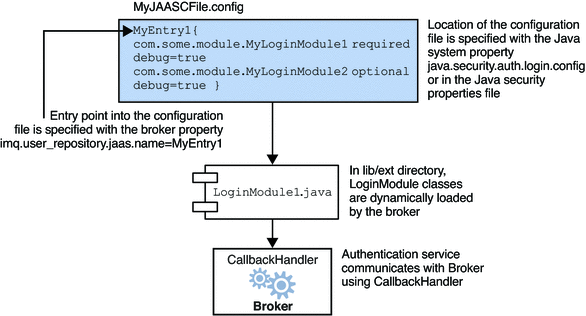JAAS Support
In addition to the file-based and LDAP-based built-in authentication mechanisms, Message Queue also supports the Java Authentication and Authorization Service (JAAS), which allows you to plug a variety of services into the broker to authenticate Message Queue clients. This section describes the information that the broker makes available to a JAAS-compliant authentication service, and it explains how you configure the broker to use such a service.
It is beyond the scope of this document to describe the JAAS API. Please consult the following sources if you need to know more.
-
For complete information about the JAAS API, please see the Java Authentication and Authorization Service (JAAS) Reference Guide.
http://java.sun.com/j2se/1.5.0/docs/guide/security/jaas/JAASRefGuide.html
-
For information about writing a LoginModule, please see the Java Authentication and Authorization Service (JAAS) LoginModule Developer's Guide.
http://java.sun.com/j2se/1.5.0/docs/guide/security/jaas/JAASLMDevGuide.html
The JAAS API is a core API in J2SE and therefore it is an integral part of Message Queue's runtime environment. JAAS defines an abstraction layer between an application and an authentication mechanism, allowing the desired mechanism to be plugged in with no change to application code. In the case of the Message Queue service, the abstraction layer lies between the broker (application) and an authentication provider. By setting a few broker properties, it is possible to plug in any JAAS-compliant authentication service and to upgrade this service with no disruption or change to broker code.
You can use JMX clients to manage the broker if you are using JAAS-based authentication, but you must manually set up JAAS support (by setting JAAS-related broker properties) before you start the broker. You cannot use the JMX API to change those properties.
Elements of JAAS
Figure 1–1 shows the basic elements of JAAS: a JAAS client, a JAAS-compliant authentication service, and a JAAS configuration file.
-
The JAAS client is an application that wants to perform authentication using a JAAS-compliant authentication service. It communicates with this service using a LoginModule and it is responsible for providing a callback handler that the LoginModule can call to obtain the user name, password, and other relevant information.
-
The JAAS-compliant Authentication Service consists of one or more LoginModule and of logic that performs the needed authentication. The LoginModule may include the authentication logic, or it may use a private protocol or API to communicate with a module that provides that logic.
-
The JAAS configuration file is a text file that the JAAS client uses to locate the LoginModule(s) needed to communicate with the JAAS-compliant service.
Figure 1–1 JAAS Elements

The next section explains how the Message Queue service uses these elements to provide JAAS-compliant authentication.
JAAS and Message Queue
The next figure shows how JAAS is used by the Message Queue broker. It shows a more complex implementation of the JAAS model shown in the previous figure.
Figure 1–2 How Message Queue Uses JAAS

As was shown in the simpler case, the authentication service layer is separate from the broker. The authentication service consists of one or more login modules (LoginModule) and of additional authentication modules if needed. The login modules run in the same Java virtual machine as the broker. The Message Queue broker is represented to the login module as a LogInContext and it communicates with the login module by means of a CallBackHandler that is part of the broker runtime code.
The authentication service also supplies a JAAS configuration file that contains entries to the login modules. The configuration file specifies the order in which the modules are to be used and some conditions for their use. When the broker starts up, JAAS locates the configuration file by the Java system property java.security.auth.login.config or the Java security properties file. It then selects an entry in the JAAS configuration file, according to the value of the broker property imq.user_repository.jaas.name. That entry specifies which login modules will be used for authentication. As the figure shows, it is possible for the broker to use more than one login module. (The relation between the configuration file, the login module, and the broker is shown in Figure 1–3.)
The fact that the broker uses a JAAS plug-in authentication service remains completely transparent to the Message Queue client. The client continues to connect to the broker as it did before, passing a user name and password. In turn, the broker uses a callback handler to pass this information to the authentication service, and the service uses that information to authenticate the user and return the results. If authentication succeeds, the broker grants the connection; if it fails, the client runtime returns a JMS security exception that the client must handle.
After the Message Queue client is authenticated, if there is further authorization to be done, the broker proceeds as it would normally; it consults the access control file to determine whether the authenticated client is authorized to perform the actions it undertakes: accessing a destination, consuming a message, browsing a queue, and so on.
Setting up JAAS-Compliant Authentication
Setting up JAAS-compliant authentication involves setting broker and system properties to select this type of authentication, to specify the location of the configuration file, and to specify the entries to the login modules that are going to be used.
This section illustrates how the JAAS client, the login modules, and the JAAS configuration file are related and then describes the process required to set up JAAS-compliant authentication. The next figure shows the relation between the configuration file, the login module, and the broker.
Figure 1–3 Setting Up JAAS Support

As shown in the figure, the JAAS configuration file, MyJAASCFile.config contains references to several login modules, grouped in an entry point. The broker locates the configuration file by consulting the Java system property java.security.auth.login.config or by consulting the Java Security properties file. The login modules to be used are determined by consulting the broker property imq.user_repository.jaas.name, which specifies the desired entry in the configuration file. The classes for those modules are found in the lib/ext directory.
To set up JAAS support for Message Queue, you must complete the following steps. (In a development environment all these steps might be done by the developer. In a production environment, the administrator would take over some of these tasks.)
-
Create one or more login module classes that implement the authentication service. The JAAS callback types that the broker supports are listed below.
- javax.security.auth.callback.LanguageCallback
-
The broker uses this callback to pass the authentication service the locale in which the broker is running This value can be used for localization.
- javax.security.auth.callback.NameCallback
-
The broker uses this callback to pass to the authentication service the user name specified by the Message Queue client when the connection was requested.
- javax.security.auth.callback.TextInputCallback
-
The broker uses this callback to specify the value of imq.authentication.type to the authentication service when the TextInputCallback.getPrompt() is imq.authentication.type. Right now, the only possible value for this field is basic. This indicates Base-64 password encoding.
- javax.security.auth.callback.PasswordCallback
-
The broker uses this callback to pass to the authentication service the password specified by the Message Queue client when the connection was requested.
- javax.security.auth.callback.TextOutputCallback
-
The broker uses this callback to provide logging services to the authentication service by logging the text output to the broker's log file. The callback's MessageType ERROR, INFORMATION, WARNING are mapped to the broker log levels ERROR, INFO, and WARNING respectively.
-
Create a JAAS configuration file with entries that reference the login module classes and specify the location of this file to the Message Queue administrator. (The file can be located remotely, and its location can be specified with a url.)
-
Note the name of the entry (that references the login implementation classes) in the JAAS configuration file.
-
Archive the classes that implement the login modules to a jar file, and place the jar file in the Message Queue lib/ext directory.
-
Configure the broker properties that relate to JAAS support. These are described in Table 1–2.
-
Set the following system property to specify the location of the JAAS configuration file.
java.security.auth.login.config=JAAS_Config_File_Location
For example, you can specify the configuration file when you start the broker.
imqbrokerd -Djava.security.auth.login.config=JAAS_Config_File_Location
There are other ways to specify the location of the JAAS configuration file. For additional information, please see
http://java.sun.com/j2se/1.5.0/docs/guide/security/jaas/tutorials/LoginConfigFile.html
The following table lists the broker properties needed to set up JAAS support.
Table 1–2 Broker Properties for JAAS Support|
Property |
Description |
|---|---|
|
imq.authentication.type |
Set to basic to indicate Base-64 password encoding. This is the only permissible value for JAAS authentication. |
|
imq.authentication.basic.user_repository |
Set to jaas to specify JAAS authentication. |
|
imq.accesscontrol.type |
Set to file. |
|
imq.user_repository.jaas.name |
Set to the name of the desired entry (in the JAAS configuration file) that references the login modules you want to use as the authentication mechanism. This is the name you noted in Step 3. |
|
imq.user_repository.jaas.userPrincipalClass |
This property, used by Message Queue access control, specifies the java.security.Principal implementation class in the login module(s) that the broker uses to extract the Principal name to represent the user entity in the Message Queue access control file. If, it is not specified, the user name passed from the Message Queue client when a connection was requested is used instead. |
|
imq.user_repository.jaas.groupPrincipalClass |
This property, used by Message Queue access control, specifies the java.security.Principal implementation class in the login module(s) that the broker uses to extract the Principal name to represent the group entity in the Message Queue access control file. If, it is not specified, the group rules, if any, in the Message Queue access control file are ignored. |
- © 2010, Oracle Corporation and/or its affiliates
